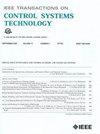基于速度障碍控制障碍函数的动态避碰
IF 3.9
2区 计算机科学
Q1 AUTOMATION & CONTROL SYSTEMS
引用次数: 0
摘要
由于控制输入可能没有出现在控制李雅普诺夫函数(clf)和控制障碍函数(cbf)的约束中,从而导致控制器失效,因此为加速控制独轮车机器人设计安全关键型控制器具有挑战性。现有的方法通常依赖于基于状态反馈的clf和高阶cbf (hocbf),这两种方法的构建计算成本很高,并且无法在快速移动的动态环境中保持有效性。为了解决这些挑战,我们提出在速度空间中构建基于速度障碍(VO)的cbf (vocbf)来增强动态避碰能力,而不是依赖于需要引入hocbf的基于距离的cbf。此外,通过使用VO的变体扩展VOCBFs,我们实现了机器人之间的反应性碰撞避免。将基于状态反馈的导航clf和用于避碰的vocbf集成在一起,构建了一种基于混合整数二次规划(MIQP)的加速控制独轮车机器人安全关键控制器。为了提高求解MIQP的效率,我们将MIQP分解为多个子优化问题,并采用决策网络来降低计算成本。数值模拟结果表明,该方法能有效地引导机器人到达目标,同时避免碰撞。与hocbf相比,vocbf的动态避障性能显著提高,特别是当障碍物快速移动且靠近机器人时。此外,我们将该方法扩展到分布式多机器人系统。本文章由计算机程序翻译,如有差异,请以英文原文为准。
Dynamic Collision Avoidance Using Velocity Obstacle-Based Control Barrier Functions
Designing safety-critical controllers for acceleration-controlled unicycle robots is challenging, as control inputs may not appear in the constraints of control Lyapunov functions (CLFs) and control barrier functions (CBFs), leading to invalid controllers. Existing methods often rely on state-feedback-based CLFs and high-order CBFs (HOCBFs), which are computationally expensive to construct and fail to maintain effectiveness in dynamic environments with fast-moving, nearby obstacles. To address these challenges, we propose constructing velocity obstacle (VO)-based CBFs (VOCBFs) in the velocity space to enhance dynamic collision avoidance capabilities, instead of relying on distance-based CBFs that require the introduction of HOCBFs. Additionally, by extending VOCBFs using variants of VO, we enable reactive collision avoidance between robots. We formulate a safety-critical controller for acceleration-controlled unicycle robots as a mixed-integer quadratic programming (MIQP), integrating state-feedback-based CLFs for navigation and VOCBFs for collision avoidance. To enhance the efficiency of solving the MIQP, we split the MIQP into multiple suboptimization problems and employ a decision network to reduce computational costs. Numerical simulations demonstrate that our approach effectively guides the robot to its target while avoiding collisions. Compared to HOCBFs, VOCBFs exhibit significantly improved dynamic obstacle avoidance performance, especially when obstacles are fast moving and close to the robot. Furthermore, we extend our method to distributed multirobot systems.
求助全文
通过发布文献求助,成功后即可免费获取论文全文。
去求助
来源期刊

IEEE Transactions on Control Systems Technology
工程技术-工程:电子与电气
CiteScore
10.70
自引率
2.10%
发文量
218
审稿时长
6.7 months
期刊介绍:
The IEEE Transactions on Control Systems Technology publishes high quality technical papers on technological advances in control engineering. The word technology is from the Greek technologia. The modern meaning is a scientific method to achieve a practical purpose. Control Systems Technology includes all aspects of control engineering needed to implement practical control systems, from analysis and design, through simulation and hardware. A primary purpose of the IEEE Transactions on Control Systems Technology is to have an archival publication which will bridge the gap between theory and practice. Papers are published in the IEEE Transactions on Control System Technology which disclose significant new knowledge, exploratory developments, or practical applications in all aspects of technology needed to implement control systems, from analysis and design through simulation, and hardware.
 求助内容:
求助内容: 应助结果提醒方式:
应助结果提醒方式:


